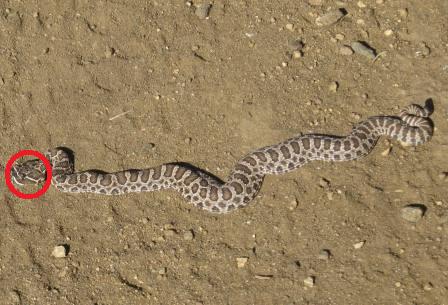Say Hello to My Little (Rattlesnake) Friend
Rather than suffer trauma-by-TV, Lilly and I went for a hike Sunday, September 11, 2011. It’s our version of praying, I suppose you could say.
It has been a HUGE snake year with many sightings nearby, so I’m ever-vigilant … constantly sweeping the trail ahead with my eyes.
Look what I found:
In person, the very young snake looked quite red in its markings, so I assumed it was a bull snake, not a rattlesnake.
Still, it looked content to snooze in the sun, in the middle of the trail, so we gingerly made our way AROUND it. Only after getting safely to the other side did I use the ZOOM on my camera to get this image.
With the naked eye, I would have sworn that the little snake had its head curved around on top of the loop in the “neck” area. And, I saw no rattles on the right end, so …
However, when I saw the full image on my computer and enlarged it, I realized the whole left END of the snake was its BIG, heart-shaped VIPER head.
Tom helped me see my mistake and gave me no end of @#$@# for making a WRONG trail-side snake ID.
I know it’s hard to have perspective, but I wasn’t about to lay something next to it for context. So, let me just say, that this young snake was only about 6-8 inches long and about the diameter of one of my fingers. (And, I’m a relatively small person.)
Now, there is a lot of talk about very young rattlesnakes being MORE dangerous than bigger, older ones … some say because they have no rattles with which to warn you. Others say it’s because they unleash every ounce of venom they’ve got because they haven’t learned to control it.
I wanted to clarify that point, so I emailed my “venomous snake expert” at Southeastern Louisiana University, Dr. Brian Crother.
I first interviewed him in 2010, while working on a dogs + snakes magazine article. The piece included the real-life tale of a large bloodhound who died about a year after suffering multiple strikes from a large Western Diamondback Rattlesnake in California. The venom destroyed his kidneys. So, while the bloodhound survived the initial emergency, he later died from damage done.
If you’re new to our Champion of My Heart community, I’ll add quickly that Lilly has survived TWO rattlesnake bites to the face in recent years: Rattlesnake bite –> fall 2008, Rattlesnake bite –> summer 2010, and a near miss in summer 2010.
Keep in mind that relatively speaking prairie rattlesnakes we have here in my part of Colorado deliver less toxic venom than either of the diamondbacks (east or west) and the Mohave ones. Still … dogs die from bites here in Colorado, too. We’ve just been LUCKY.
Oh, and since everyone asks, these are my thoughts on rattlesnake aversion training for dogs.
Anyway, I emailed Dr. Crother the photo above to:
- Confirm it’s indeed a baby rattlesnake
- Find out why very young snakes can be so dangerous
Here is his reply (emphasis mine):
“Hi Roxanne: I am happy to help! Hey, that is a good looking little prairie rattlesnake. You gotta be careful around those little guys because juvenile (two weeks to three months old) prairie rattlers (and some others) have venom twice as potent as older snakes. But, they are able to control their venom delivery and they apparently can do so quite well. So these real young snakes are dangerous because their venom is more toxic, not because they can’t control venom delivery.”
The good news is that Lilly had NO idea there was a snake. Not a clue. She didn’t see it (likely because it wasn’t moving). She didn’t smell it … which is interesting … because on that same hike she snuffled around on the side of the trail and found this shed snake skin.
We, and our neighbors, have found many skins around lately. Looks like all the snakes are getting a fresh outer layer before winter.


